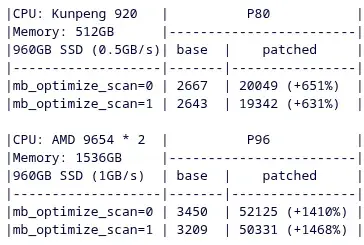shows wild gains
Pffft… typical hyperbolic headline
1400%
Okay, that’s pretty wild.
Do the other FSes even lift, bro?
there was a significant decrease in file fragmentation
is that relevant for SSD users?
With Linux servers continuing to have more CPU cores and more containers being loaded on each server, Huawei began noticing scalability issues within the EXT4 file-system driver code.
Simply put, the fallocate operations per container per second are able to come up significantly
So these improvements are for high-load scenarios, right? Casual users won’t notice any improvements? (Not to bash this contribution, just asking)
I suppose common users will have marginal improvements, as we don’t move a lot of data. High load because long I/O waits in VM farms is a big deal, though, so this is actually great for companies with self-hosted VDI.
How is the first table interpreted? base=before and patched=after?
But that would mean that after takes more time, so I must be making some wrong assumption.
Not time, ops per second.
the fallocate operations per container per second are able to come up significantly when looking at the upper percentiles:
Thanks, I didn’t read that properly.





